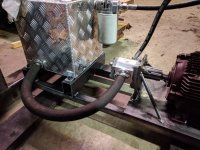Hi guys just got done putting together a press and plumbed it today, left it running a few minutes and next thing foamy oil is erupting out of the filler neck so I'm getting a heap of air in my circuit somehow, watching the return line it behaves like a garden hose coughing it's air out when first turned on (big bubbles, pockets, not micro bubbles).
I'm just wondering what the heck could cause this, if I don't have any leaks? My best guess is I have reduced the intake size by quite a bit by converting from a European flange mount style to a BSP thread as noone in NZ really stocks fittings for flange style. So I have reduced a ~19mm hole to whatever the ID is of a 1/2" BSP nipple. Is that enough to cause this behaviour? I would've expected if it was cavitating it wouldn't be pumping big air pockets around the circuit but rather dragging a tiny amount of dissolved air out of the oil, possibly...? Is it this simple?
Circuit is 1/2" hose from bottom of tank to pump, flooded inlet (tank above), and for simplicity sake let's say pump to filter via 3/8 hose (problem still shows with this simpler circuit), filter screwed directly into top of tank then flows down internal spout to just above the floor of the tank. There's a baffle in the tank but not blocking flow whatsoever. I can see waves in the tank, not well but what looks more like air bubbles than general turbulence.
It's a casappa pump, my best guess is a Polaris 20D, nothing written on it so don't know specs for sure. Spinning it at ~1400rpm. Might not be quite up the right isle for this forum but I suspect the knowledge will see me right...
Thanks in advance as always

I'm just wondering what the heck could cause this, if I don't have any leaks? My best guess is I have reduced the intake size by quite a bit by converting from a European flange mount style to a BSP thread as noone in NZ really stocks fittings for flange style. So I have reduced a ~19mm hole to whatever the ID is of a 1/2" BSP nipple. Is that enough to cause this behaviour? I would've expected if it was cavitating it wouldn't be pumping big air pockets around the circuit but rather dragging a tiny amount of dissolved air out of the oil, possibly...? Is it this simple?
Circuit is 1/2" hose from bottom of tank to pump, flooded inlet (tank above), and for simplicity sake let's say pump to filter via 3/8 hose (problem still shows with this simpler circuit), filter screwed directly into top of tank then flows down internal spout to just above the floor of the tank. There's a baffle in the tank but not blocking flow whatsoever. I can see waves in the tank, not well but what looks more like air bubbles than general turbulence.
It's a casappa pump, my best guess is a Polaris 20D, nothing written on it so don't know specs for sure. Spinning it at ~1400rpm. Might not be quite up the right isle for this forum but I suspect the knowledge will see me right...
Thanks in advance as always






